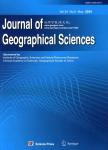基于多源数据的长沙市人居热环境效应及其影响因素分析
Effect of human settlements on urban thermal environment and factor analysis based on multi-source data:A case study of Changsha city作者机构:College of ArchitectureChangsha University of Science and TechnologyChangsha 410076China Hunan Key Lab of Land Resource Evaluation&UtilizationChangsha 410007China Research Center of Resource Environment and Urban PlanningChangsha 410114China
出 版 物:《Journal of Geographical Sciences》 (地理学报(英文版))
年 卷 期:2021年第31卷第6期
页 面:819-838页
核心收录:
学科分类:0709[理学-地质学] 07[理学] 08[工学] 070602[理学-大气物理学与大气环境] 0706[理学-大气科学] 0704[理学-天文学] 0833[工学-城乡规划学] 083303[工学-住房与社区建设规划]
基 金:National Social Science Foundation of China,No.15BJY051 Open Topic of Hunan Key Laboratory of Land Resources Evaluation and Utilization,No.SYS-ZX-202002 Research Project of Appraisement Committee of Social Sciences Research Achievements of Hunan Province,No.XSP18ZDI031。
主 题:thermal environment natural-human factor multi-source data spatial PCA Changsha city
摘 要:In view of the lack of comprehensive evaluation and analysis from the combination of natural and human multi-dimensional factors,the urban surface temperature patterns of Changsha in 2000,2009 and 2016 are retrieved based on multi-source spatial data(Landsat 5 and Landsat 8 satellite image data,POI spatial big data,digital elevation model,etc.),and 12 natural and human factors closely related to urban thermal environment are quickly obtained.The standard deviation ellipse and spatial principal component analysis(PCA)methods are used to analyze the effect of urban human residential thermal environment and its influencing factors.The results showed that the heat island area increased by 547 km~2 and the maximum surface temperature difference reached 10.1℃during the period 2000–2016.The spatial distribution of urban heat island was mainly concentrated in urban built-up areas,such as industrial and commercial agglomerations and densely populated urban centers.The spatial distribution pattern of heat island is gradually decreasing from the urban center to the suburbs.There were multiple high-temperature centers,such as Wuyi square business circle,Xingsha economic and technological development zone in Changsha County,Wangcheng industrial zone,Yuelu industrial agglomeration,and Tianxin industrial zone.From 2000 to 2016,the main axis of spatial development of heat island remained in the northeast-southwest direction.The center of gravity of heat island shifted 2.7 km to the southwest with the deflection angle of 54.9°in 2000–2009.The center of gravity of heat island shifted to the northeast by 4.8 km with the deflection angle of 60.9°in 2009–2016.On the whole,the change of spatial pattern of thermal environment in Changsha was related to the change of urban construction intensity.Through the PCA method,it was concluded that landscape pattern,urban construction intensity and topographic landforms were the main factors affecting the spatial pattern of urban thermal environment of Changsha.The promotion effect of human factors on the formation of heat island effect was obviously greater than that of natural factors.The temperature would rise by 0.293℃under the synthetic effect of human and natural factors.Due to the complexity of factors influencing the urban thermal environment of human settlements,the utilization of multi-source data could help to reveal the spatial pattern and evolution law of urban thermal environment,deepen the understanding of the causes of urban heat island effect,and clarify the correlation between human and natural factors,so as to provide scientific supports for the improvement of the quality of urban human settlements.



